Top Rankings
Ewing Township School District ranks among the top 20% of public school district in New Jersey for:
Category
Attribute
Diversity
Most diverse schools (Top 1%)
Community Size
Largest student body (number of students) (Top 1%)
For the 2025 school year, there is 1 public middle school serving 773 students in Ewing Township School District. This district's average middle testing ranking is 2/10, which is in the bottom 50% of public middle schools in New Jersey.
Public Middle School in Ewing Township School District have an average math proficiency score of 21% (versus the New Jersey public middle school average of 32%), and reading proficiency score of 29% (versus the 48% statewide average).
Minority enrollment is 81% of the student body (majority Black), which is more than the New Jersey public middle school average of 68% (majority Hispanic).
Overview
This School District
This State (NJ)
# Schools
5 Schools
835 Schools
# Students
3,521 Students
458,046 Students
# Teachers
325 Teachers
39,885 Teachers
Student : Teacher Ratio
11:1
11:1
District Rank
Ewing Township School District, which is ranked within the bottom 50% of all 646 school districts in New Jersey (based off of combined math and reading proficiency testing data) for the 2021-2022 school year.
The school district's graduation rate of 70% has decreased from 92% over five school years.
Overall District Rank
#553 out of 650 school districts
(Bottom 50%)
(Bottom 50%)
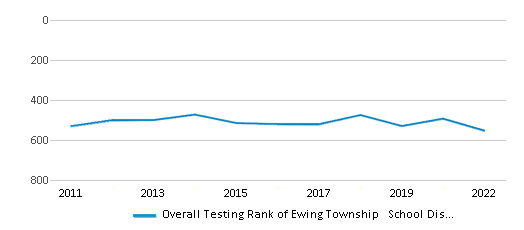
Math Test Scores (% Proficient)
20%
36%

Reading/Language Arts Test Scores (% Proficient)
29%
49%
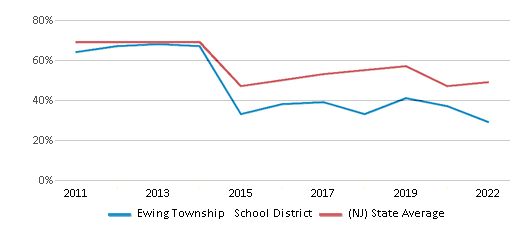
Science Test Scores (% Proficient)
12%
23%
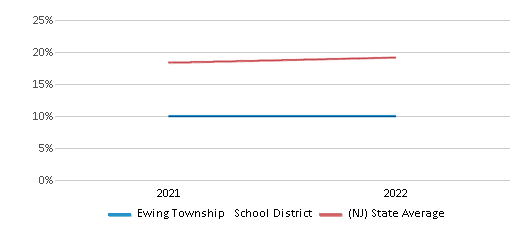
Graduation Rate
70%
85%

Students by Ethnicity:
Diversity Score
0.70
0.72
# American Indian Students
3 Students
913 Students
% American Indian Students
n/a
n/a
# Asian Students
146 Students
39,872 Students
% Asian Students
4%
9%
# Hispanic Students
965 Students
173,877 Students
% Hispanic Students
28%
38%
# Black Students
1,528 Students
84,536 Students
% Black Students
44%
18%
# White Students
682 Students
145,711 Students
% White Students
19%
32%
# Hawaiian Students
4 Students
858 Students
% Hawaiian Students
n/a
n/a
# Two or more races Students
188 Students
12,134 Students
% of Two or more races Students
5%
3%
Students by Grade:
# Students in PK Grade:
78
12,448
# Students in K Grade:
253
19,022
# Students in 1st Grade:
265
19,268
# Students in 2nd Grade:
268
19,849
# Students in 3rd Grade:
242
20,625
# Students in 4th Grade:
271
22,766
# Students in 5th Grade:
251
30,973
# Students in 6th Grade:
255
79,058
# Students in 7th Grade:
267
100,830
# Students in 8th Grade:
251
101,895
# Students in 9th Grade:
298
8,812
# Students in 10th Grade:
285
7,480
# Students in 11th Grade:
271
7,369
# Students in 12th Grade:
266
7,529
# Ungraded Students:
-
122
District Revenue and Spending
The revenue/student of $27,179 is higher than the state median of $26,931. The school district revenue/student has stayed relatively flat over four school years.
The school district's spending/student of $27,879 is higher than the state median of $25,828. The school district spending/student has stayed relatively flat over four school years.
Total Revenue
$96 MM
$36,642 MM
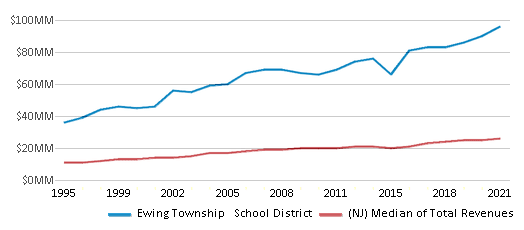
Spending
$98 MM
$35,142 MM
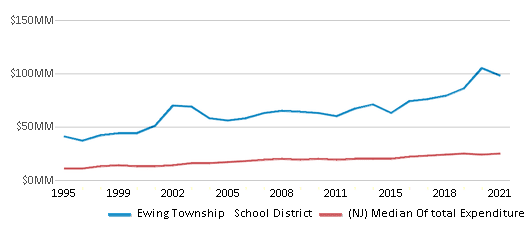
Revenue / Student
$27,179
$26,931
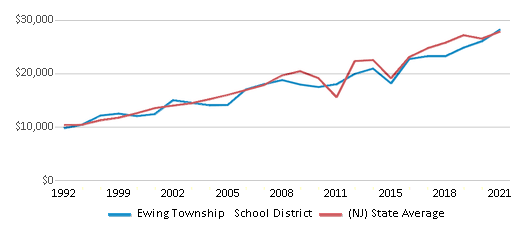
Spending / Student
$27,879
$25,828
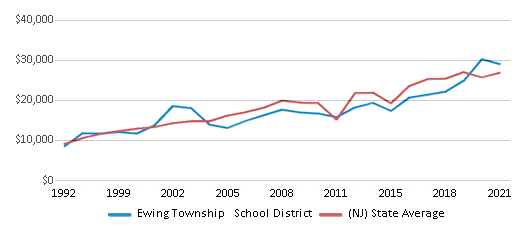
Best Ewing Township School District Public Middle Schools (2025)
School
(Math and Reading Proficiency)
(Math and Reading Proficiency)
Location
Grades
Students
Rank: #11.
Gilmore J Fisher Middle School
(Math: 21% | Reading: 29%)
Rank:
Rank:
3/
Bottom 50%10
1325 Lower Ferry Road
Trenton, NJ 08618
(609) 538-9800
Trenton, NJ 08618
(609) 538-9800
Grades: 6-8
| 773 students
Recent Articles

What Is A Charter School?
Explore the world of charter schools in this comprehensive guide. Learn about their history, how they operate, and the pros and cons of this educational innovation. Discover key facts about charter schools, including admission policies, demographics, and funding, as well as what to look for when considering a charter school for your child.

10 Reasons Why High School Sports Benefit Students
Discover the 10 compelling reasons why high school sports are beneficial for students. This comprehensive article explores how athletics enhance academic performance, foster personal growth, and develop crucial life skills. From improved fitness and time management to leadership development and community representation, learn why participating in high school sports can be a game-changer for students' overall success and well-being.

February 05, 2025
Understanding the U.S. Department of Education: Structure, Impact, and EvolutionWe explore how the Department of Education shapes American education, from its cabinet-level leadership to its impact on millions of students, written for general audiences seeking clarity on this vital institution.





